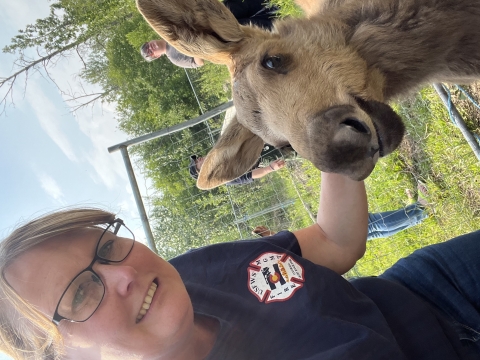Canada is experiencing its most destructive wildfire season on record. Hundreds of fires are currently burning from coast to coast, sending plumes of smoke into the atmosphere across the entire country and into the United States.
The broad range of fires occurring, from the westernmost provinces to the eastern ones, is unusual, particularly so early in the year. As of June 30, the Canadian Interagency Forest Fire Centre has recorded 3,056 wildfires since the beginning of 2023. The fires have burned at least 8.1 million hectares — or around 20 million acres — of land across Canada.
Once fire season began in Canada, the Canadian Interagency Forest Fire Centre began requesting assistance from the National Interagency Fire Center in the United States. Since May 8, the U.S. has mobilized a total of 1,362 personnel to Canada. Positions assisting Canadian fires include fire staff at all levels, from on-the-ground firefighters to overhead personnel. Overhead personnel refers to personnel assigned to supervisory positions, unit leaders, managers and other specialists. The U.S. Fish and Wildlife Service has provided around 15 personnel to assist in several aspects of these suppression efforts.
To learn about the wildfire conditions and contributions of the USFWS team, we talked with Bill Waln, USFWS Zone Fire Management Officer for the Mid-Plains Fire Management Zone, which encompasses Nebraska, Kansas, and Colorado. Waln is currently serving as the Incident Commander (IC) of the Rocky Mountain Area Complex Incident Management Team (CIMT) managing the South Peace Complex in British Columbia.
What does your role as the Incident Commander for the Rocky Mountain Area Complex Incident Management Team entail?
As part of my role as the Incident Commander of the Rocky Mountain Area CIMT I ensure the team’s objectives are aligned with those provided by the British Columbia Wildfire Service. I meet daily with our liaison from British Columbia Wildfire Service to review strategies, tactics, and objectives and map out the day’s best course of action to continue suppression efforts.
Who makes up the Rocky Mountain Area CIMT?
This specific Rocky Mountain Area CIMT is comprised of members from all three CIMT’s in the Rocky Mountain Area. The team is made up of several federal agencies including, USFWS, USDA Forest Service, and Bureau of Land Management. The Rocky Mountain Area worked hard to fill the order for a CIMT, but due to availability of resources, we had to pull from all three Rocky Mountain Area CIMT’s to form a full roster.
You mentioned there were other U.S. Fish and Wildlife Service personnel on the Rocky Mountain Area CIMT in Canada right now. Who are they and what is their role?
Shawna Martinez, a Fire Program Assistant for the Mid-Plains Management Zone, is also serving on the Rocky Mountain Area CIMT in Canada. She is filling the role of Resource Unit Leader and is responsible for establishing all incident check-in activities including preparing and processing resource status information and maintaining a master list of resources assigned to the incident. Additionally, she creates and updates the daily Incident Action Plan which typically includes incident and tactical objectives, organizational and assignment lists, communications plan, medical plan, incident maps, and other information as needed, such as an air operations summary.
Where are you currently stationed in Canada and what fires are you managing?
The Rocky Mountain Area CIMT is managing the South Peace Complex in British Columbia. The Incident Command Post is in Dawson Creek, B.C. There are two fires that make up the South Peace Complex: Peavine Fire (644 Fire) and West Kiskatinaw River Fire (645 Fire), both located in the Prince George Fire Centre, Dawson Creek Fire Zone.
As of June 30, the Peavine Fire is 4,427 hectares (10,939 acres) and has a status of "Being Held," which means it is not likely to spread beyond predetermined boundaries under current conditions. The West Kiskatinaw River status is "Out of Control" and is 25,095 hectares (62,011 acres). Out of Control is a wildfire that is continuing to spread and/or is not responding to suppression efforts.
What is the fire situation in British Columbia right now?
British Columbia is experiencing very warm and dry conditions. The fire season started six weeks early and has not yet reached its historic peak. The Drought Code is setting records for hot, dry conditions. The Drought Code is a numeric rating of the average moisture content of deep, compact organic layers. This code is a useful indicator of seasonal drought effects on forest fuels and the amount of smoldering in deep duff layers and large logs. The Buildup Index is exceeding the 90th percentile. The Buildup Index is similar to the Energy Release Component used in the United States National Fire Danger Rating System. Initial attack is the priority, keeping fires as small as possible.
How are you working in conjunction with the Canadian authorities and firefighters?
As part of Rocky Mountain Area CIMT, we have combined several Canadian single resources into the team. There are several differences in how Canada uses the Incident Command System and having Canadian's embedded with our CIMT helps us understand and adapt to those differences. We adapt to the conditions to which we face, while using our familiar processes and procedures. As part of a continued learning process, we have been asked to provide feedback on the differences and similarities between Canadian Incident Management Teams and U.S. CIMTs.
What is it like working with the British Columbia Wildfire Service?
BC Wildfire Service is taking very good care of us. We are very appreciative of their hospitality. The organization reminds me of the USFWS fire program in that it is a small and nimble program. They are a learning organization constantly seeking to improve the performance of their Incident Management Teams and firefighters. When they arrive on scene, the BC Wildfire Service comes equipped with more medical staff and support equipment than I’m used to. They’re a small agency that can do a lot with a little.







